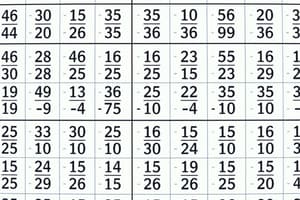Podcast
Questions and Answers
What is the main purpose of multiplication tables?
What is the main purpose of multiplication tables?
- To confuse students with complex math problems
- To introduce students to the concept of division
- To help students learn and recall multiplication facts (correct)
- To eliminate the need for understanding multiplication
How are multiplication tables organized?
How are multiplication tables organized?
- By focusing on subtraction strategies
- By teaching addition concepts
- By using visual arrays of dots
- By listing multiplication problems in a grid or table (correct)
What does 3 rows with 4 dots in each row represent visually?
What does 3 rows with 4 dots in each row represent visually?
- 12 dots in total (correct)
- 4 times 3 dots
- 15 dots in total
- 3 times 5 dots
How do students use multiplication tables?
How do students use multiplication tables?
Why are multiplication tables considered an essential tool?
Why are multiplication tables considered an essential tool?
What is the purpose of breaking down a multi-digit number in long multiplication?
What is the purpose of breaking down a multi-digit number in long multiplication?
What should be done if a column in long multiplication has a product of 10 or more?
What should be done if a column in long multiplication has a product of 10 or more?
Why are place values important in long multiplication?
Why are place values important in long multiplication?
What step follows multiplying each digit by the digit in the multiplier in long multiplication?
What step follows multiplying each digit by the digit in the multiplier in long multiplication?
What is the final result of multiplying 12 by 54 using long multiplication?
What is the final result of multiplying 12 by 54 using long multiplication?
Flashcards are hidden until you start studying
Study Notes
Multiplication is a fundamental arithmetic operation that involves finding the total number of items in equal groups. It is typically introduced as repeated addition or equal groups of items. Multiplication tables are used to help students remember and recall multiplication facts, which are the answers to multiplication problems up to 10x10.
Multiplication as equal groups is a visual way to understand multiplication. For example, if you visited your neighbor's dog Tuffy 5 times and gave him 2 treats each time, you can represent this as 5 times 2, or 10 treats in total. Similarly, if you have an array of dots arranged in rows, you can use multiplication to find the total number of dots. For instance, if there are 3 rows with 4 dots in each row, there are 12 dots in total.
Multiplication tables are often used to help students memorize and recall multiplication facts. These tables can be organized in various ways, such as by using a grid or a list of multiplication problems. For example, the multiplication table for 2x2 would be:
| × | 1 | 2 | 3 | 4 | 5 | 6 | 7 | 8 | 9 | 10 |
|---|---|---|---|---|---|---|---|---|---|---|
| 1 | 2 | 4 | 6 | 8 | 10 | 12 | 14 | 16 | 18 | 20 |
| 2 | 4 | 8 | 12 | 16 | 20 | 24 | 28 | 32 | 36 | 40 |
Students can use this table to find the answer to any multiplication problem, such as 3 × 4 = 12 or 5 × 7 = 35.
In conclusion, multiplication tables are an essential tool for helping students learn and recall multiplication facts. They provide a visual and organized way to understand the concept of multiplication as equal groups or repeated addition. Through practice and memorization, students can become proficient in using multiplication to solve a variety of problems.
Studying That Suits You
Use AI to generate personalized quizzes and flashcards to suit your learning preferences.




